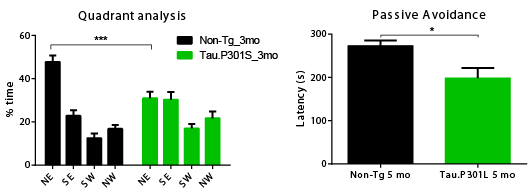reMYND’s Tau.P301L and Tau.P301S models feature progressive hyperphosphorylation of Tau with age and a strong correlation of Tau pathology with the motor phenotype. A NFT-like pathology is found in numerous brain regions including brainstem, spinal cord, cortex and hippocampus. In young animals, before the onset of NFT pathology, these models exhibit impaired synaptic plasticity (as assessed by measuring Long Term Potentiation). We have now corroborated these findings by demonstrating a cognitive deficit in both models which precedes the onset of NFT pathology and motor deficit (Figure 1).

Figure 1: Quadrant analysis during the probe trial (left), Morris Water Maze with 3 month old Tau.P301S and age-matched non transgenic control animals (N = 17 per group, NE = Target Quadrant). Passive Avoidance behaviour of 5 month old Tau.P301L and non transgenic control animals (right, N = 17 per group).
For more information on reMYND’s transgenic mouse models, please contact Bart Roucourt, CRO Manager.













